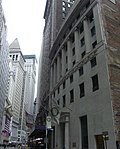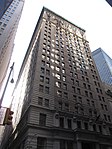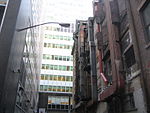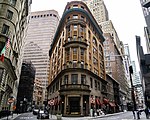Broad Street (Manhattan)

Broad Street is a north–south street in the Financial District of Lower Manhattan in New York City. Originally the Broad Canal in New Amsterdam, it stretches from today's South Street to Wall Street. The canal drew its water from the East River, and was infilled in 1676 after numerous fruit and vegetable vendors made it difficult for boats to enter the canal. Early establishments on Broad Street in the 1600s included the Fraunces Tavern and the Royal Exchange. Later on the area became the center of financial activity, and all smaller buildings in turn were replaced with grand banks and stock exchange buildings. Most of the structures that stand today date from the turn of the 20th century, along with more modern buildings constructed after the 1950s.
Excerpt from the Wikipedia article Broad Street (Manhattan) (License: CC BY-SA 3.0, Authors, Images).Broad Street (Manhattan)
Beaver Street, New York Manhattan
Geographical coordinates (GPS) Address Nearby Places Show on map
Geographical coordinates (GPS)
| Latitude | Longitude |
|---|---|
| N 40.705 ° | E -74.0116 ° |
Address
Lenscrafter
Beaver Street
10005 New York, Manhattan
New York, United States
Open on Google Maps










